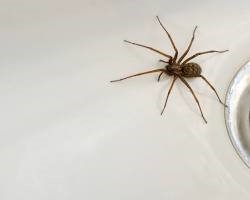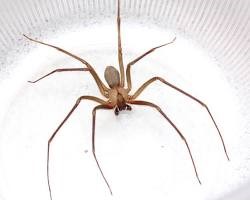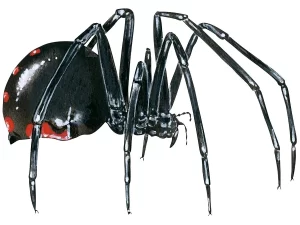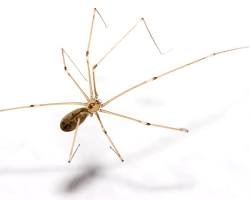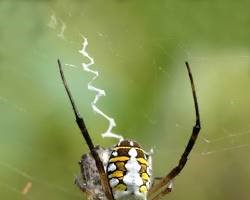Southern California Exterminators
6 Most Common Types of Spiders in Orange County
Here are the 6 most common types of spiders you'll find in Orange County, CA:
The American House Spider, scientifically known as Parasteatoda tepidariorum, is a common spider found in households. This spider has a light brown to reddish-brown body, measuring about ¼ inch in length, with long and slender legs. They are typically found in attics, basements, crawlspaces, corners, and closets inside homes, where they build irregular webs with funnel retreats.
American House Spiders are known for their non-aggressive behavior and are more likely to flee than to bite. Their bites are generally harmless to humans. If you come across this spider in your home, there’s no need to panic as they are not considered a threat.
Yellow Sac Spiders, scientifically known as Cheiracanthium inclusum, are easily identifiable by their pale yellow bodies which measure about ¼ to ½ inch long, and darker legs. These spiders are commonly found in attics, basements, walls, ceilings, and around windows inside houses where they construct small, white, sac-like webs in corners. Yellow Sac Spiders are generally non-threatening but may bite if they feel disturbed; however, their bites are typically not serious.
The brown recluse spider, scientifically known as Loxosceles reclusa, is not commonly found in California. These spiders have a light to dark brown body, about half an inch long, with a distinctive violin-shaped marking on their back. They prefer dry, undisturbed areas such as attics, basements, closets, behind furniture, and in crawlspaces. Unlike other spiders, they do not build webs.
The Black Widow Spider is one of the most well-known and poisonous spiders in the United States. Identified by its shiny black body and red hourglass mark on its abdomen, these spiders are commonly found in dark and secluded areas such as garages, basements, closets, and hidden woodpiles.
Beware of their bite, as it can cause severe pain, muscle spasms, and nausea. In extreme cases, Black Widow Spider bites can even be deadly. If you come across a Black Widow Spider, do not try to handle or kill it on your own. Instead, contact a professional exterminator right away and seek medical attention if you are bitten. Stay safe and vigilant around these dangerous spiders.
Black Widow Spider
The Black Widow spider, scientifically known as Latrodectus hesperus, is easily recognized by its adult females with a shiny black body and a distinctive red hourglass marking on the underside of their abdomen. Males, on the other hand, are smaller and have brown or gray bodies with different markings. These spiders are commonly found in outdoor areas such as woodpiles, rockpiles, under debris, and around gardens where they construct messy webs in sheltered spots. While Black Widows are generally shy, they may bite if they feel threatened. Their bites can be severe and necessitate medical treatment.
Daddy longlegs, scientifically known as Pholcus phalangioides, are small insects with an oval-shaped, light brown body and incredibly long, slender legs. They can commonly be found in attics, basements, garages, sheds, and outdoor areas like under eaves and porches where they build irregular webs with long, tangled threads. Despite their spooky appearance, daddy longlegs are harmless to humans and actually beneficial as they feed on other insects.
The Orb Weaver Spider, also known as Araneus spp., encompasses many species with variable appearances in terms of size and color. Most commonly recognized by their round, bulbous abdomen and eight legs, these spiders are typically found in gardens, trees, shrubs, and other outdoor locations. They are known for building large, intricate circular webs with radial spokes. While not aggressive, Orb Weaver Spiders may bite if provoked, with their bites usually causing mild effects.
Does Homeowners Insurance Cover Termite Damage?
Insurance providers generally do not cover the expenses related to termite damage and removal under standard home, condo, or renters’ insurance policies. These companies view termite infestations as preventable, placing the responsibility and cost on the property owner. Thus, individuals should be prepared to bear the financial burden of addressing termite issues. Find out if homeowners insurance covers termite
damage in Orange County and what you can do to prevent and treat it. (800)-418-9263
Why homeowners’ insurance usually excludes coverage for termite damage in Orange County, CA
Does Homeowners Insurance Cover Termite Damage in Huntington Beach? Like homeowners’ insurance, renters insurance typically only covers sudden and direct losses caused by a covered peril. This means that termite damage is usually not covered by renters’ insurance. If you suspect that your rented property has termites, it is essential to promptly notify your landlord so they can arrange for a professional exterminator to address the issue.
- Maintain a two to three-foot distance between plants, mulch, and your home’s foundation. This prevents easy access for termites.
- Ensure that storm drains empty at least a few feet from your home’s foundation. This prevents moisture accumulation, which attracts termites.
- Repair any leaks in faucets, roofs, and gutters promptly. Damp areas are desirable to termites.
- When termites start swarming in the winter, turn off outdoor lights as these insects attract light sources.
- Schedule a professional pest inspection with a certified inspector, even if you believe your home is termite-free. Prevention is always better than dealing with an infestation.
- Avoid storing firewood close to your house. Termites are attracted to wood, and having firewood nearby creates an easy entry point.
- Choose treated wood for all construction projects, including your home, deck, and fences. Treated wood is less appealing to termites and helps prevent infestations.
Discover additional information regarding the coverage provided by homeowners insurance coverages.

